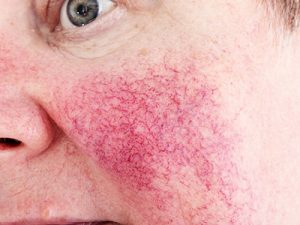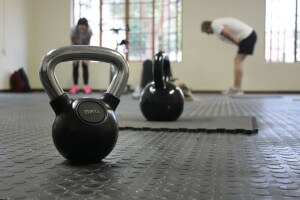26 Jul Rosacea, Swimming and Exercise
Rosacea1 is a common skin condition that starts with blushing and flushing, but can progress into persistent facial redness, pimples, pustules and sometimes facial disfigurement. The impact of rosacea goes more than skin-deep, it can have significant psychological impact, affecting confidence and self-esteem as well as reducing quality of life.
 How did Rosacea get its name?
How did Rosacea get its name?
Rosacea originates from the Latin word meaning rose-coloured. It’s an appropriate term for a chronic condition that can leave the skin with a very rosy hue.
What happens in Rosacea?
Rosacea is characterised by redness and flushing, together with acne-like bumps and pus-filled spots on the skin of the cheeks, chin, nose and forehead. The skin can tingle and burn and some people can also suffer inflammation of the eyelids and the top surface of the eyes, which can be unsightly and uncomfortable.
Rosacea is a chronic condition which relapses and remits. The severity can fluctuate over time, with people having periodic flare-ups. Some people with advanced rosacea can develop a red, bumpy, bulbous nose known as rhinophyma.
What are the causes of Rosacea?
Frustratingly, the underlying causes of rosacea are not fully understood. Your genetic heritage, the environment and the immune system are all thought to have an effect. Microbes and mites that commonly appear on the skin are thought to act as triggers of rosacea in some people. Abnormalities in the blood vessels of the skin have also been identified.
The condition can affect anyone, but women are more at risk. Fair-skinned individuals and those aged between 40 and 60 are also more vulnerable to developing rosacea.
What triggers Rosacea?
Light and lifestyle factors can make rosacea flare up. The condition is triggered by factors that make the blood vessels in the face dilate. This includes stress, sunlight, temperature and weather extremes (whether hot or cold), hot drinks, spicy food, alcohol and caffeine. Strenuous exercise can also trigger inflammation and redness.
Exercise and Rosacea
Vigorous exercise is great for your health and wellbeing, but it can also leave you hot and red in the face, which can trigger rosacea. Indeed, in a survey by the National Rosacea Society, eight in ten people said that exercise aggravated their skin, with high-intensity, aerobic exercise being particularly problematic.
You shouldn’t just sit on the sofa, though. Exercise is good for your general health, and as an effective stressbuster, it could help calm your rosacea too. The National Rosacea Society suggest that you moderate your exercise programme, choosing low to medium intensity exercise instead, which is echoed by. The NHS says:
‘As strenuous exercise can sometimes make rosacea symptoms worse, a low-intensity exercise programme, such as walking or swimming, may be better than high-intensity activities, such as running or aerobics.’2
Swimming and Rosacea
Swimming is an excellent low-impact exercise that uses most of the muscles in the body. It’s aerobic, so it challenges the heart and lungs but the cool water can prevent you overheating. That’s great for people affected by rosacea, when dilation of the blood vessels can trigger a flare.
Most public swimming pools work hard to balance water quality with careful pH control, and chlorination is used to clear any microbes. However, some people may find that the swimming pool chemicals dry and irritate their skin.
How you can swim safely and protect your skin:
- Apply an emollient, like AproDerm®, before and after swimming. Emollients form a protective layer over the skin to lock in moisture and counteract the drying effects of the pool chemicals.
- Apply your prescribed rosacea treatments diligently following a swim.
- Keep a hand-spray bottle of fresh, cool water to regularly rinse your face.
- Swim at a steady pace and take frequent breaks.
If you’d rather keep your feet on dry land, you can still exercise and help your skin stay smooth. Walking is an effective, low impact way of keeping active and enjoying the great outdoors. However, effective sun-protection and a hat is important to prevent sunlight acting as a trigger.
Low to medium intensity activities, like yoga and pilates, are also recommended by the National Rosacea Society. They build strength, balance and flexibility while keeping your heart rate and your body temperature down. The activities can also reduce psychological stress which is a significant rosacea trigger.
Whichever form of exercise you choose, there are ways of keeping your skin calm and clear:
- Drinking up: Sip cold water throughout your workout to stay cool and hydrated.
- Staying chilled: Try and workout in a place that’s cool and comfortable.
- Resting regularly: Take breaks to let your body temperature cool.
- Not overdoing it: Try and reduce the intensity of your workout.
References
1 nhs.uk. (2019). Rosacea. [online] Available at: https://www.nhs.uk/conditions/rosacea/ [Accessed 26 Jul. 2019].
2 nhs.uk. (2019). Rosacea. [online] Available at: https://www.nhs.uk/conditions/rosacea/self-help/ [Accessed 26 Jul. 2019].



Sorry, the comment form is closed at this time.